Last updated on Friday, November 20, 2020.

Dr. Pejman Bady
- Medical Director
- Head of Emergency Medical Services
- Medical degree from Western University of Health Sciences
- USC Marshall School of Business
You may not have heard of Platelet Rich Plasma (PRP) until Tiger Woods used it before the 2010 Masters. Perhaps you still have not. In fact, most people would say that PRP means nothing to them even though it’s been around for five decades.
Platelet Rich Plasma is a therapeutic injection that is quickly gaining traction in the medical community. The reason why it is relatively unknown is a head-scratcher, as athletic communities swear by PRP, and its use in treating various ailments is on the rise.
Platelets? Plasma? These might be familiar terms if you work in a hospital or similar setting, or these could be words that echo from an almost-forgotten high-school biology class. The truth is that Platelet Rich Plasma is a natural substance that is produced by your body, safely enhanced, and then reinjected into areas of injury or malady.
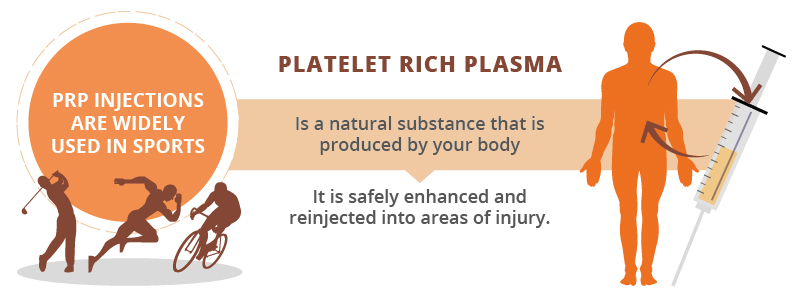
Part 1- What is Platelet Rich Plasma, exactly?
What is Platelet Rich Plasma?
Platelet Rich Plasma is astoundingly simple in concept; your doctor or medical technician inject a laboratory made concentration that is created from your own blood. That is right, your own blood. Essentially, PRP is super-charged healing plasma.
Super-charged? Like the Marvel movies? Not exactly..but the benefits from using Platelet Rich Plasma as part of your recovery could make you feel like a superhero. That is because Platelet Rich Plasma is your own natural plasma which has had the most platelet dense part of your blood added back into it. The result is a super-charged infusion of plasma with an ultra high content of platelets.
See, your blood is made of three components. Blood cells, platelets and plasma. Blood cells are further categorized into red and white, and they do different things. Red blood cells deliver oxygen to your body and white blood cells fight off infection. Platelets are the clotting agents in blood. These cells swarm around injured tissue (like cuts) and through a kind of clumping effect platelets provide structure and safety until the injured tissue replaces them with new cells.Once these platelets form the structure (or scaffolding) for new tissue, they release alpha granules which are filled with 10 different growth factors. This means that platelets are your body’s first line of defense in healing. Plasma is the liquid agent of blood which lets these cells and other nutrients move about.
So Platelet Rich Plasma is an injection of your own blood, with your own platelets separated and added back into the injection. Essentially your doctor is using your own ultra-concentrated biology to heal and repair injured tissue.

Where does Platelet Rich Plasma come from?
Platelet Rich Plasma is naturally derived from the body’s own blood supply.
What does Platelet Rich Plasma do for the body?
Platelet Rich Plasma is used as regenerative medicine, meaning it is a therapy which deals with the “process of replacing, engineering or regenerating human or animal cells, tissues or organs to restore or establish normal function” (Springer Nature Limited, 2020). To restore, as in get back to the body’s optimal state of functioning.
When the body becomes injured through trauma or illness we can experience immense pain and loss of function. A platelet rich plasma injection applied to the area of injury floods the tissue with platelets, which then act right away forming fresh bonds, a new scaffolding for tissue repair and releasing those 10 different growth factors to initiate the healing process.
The Platelet Rich Plasma procedure
When a scientific team creates PRP for therapeutic injection, they start by obtaining a few vials of your blood. These vials are placed in a machine called a centrifuge and spun around at varying speeds. As the whole blood spins it separates into three layers; red blood cells, a ‘buffy coat’ and a layer of plasma with a high concentration of platelets and other nutrients.
The plasma with the platelets and growth factors is then removed from its vial and centrifuged one more time. Next, the platelet poor plasma is removed and one is left with the platelet rich plasma which is then utilized for injection. This compound is your injection of Platelet Rich Plasma. The injection is often applied to several areas around the concerning tissue- such as the case of a torn tendon or arthritic joint.
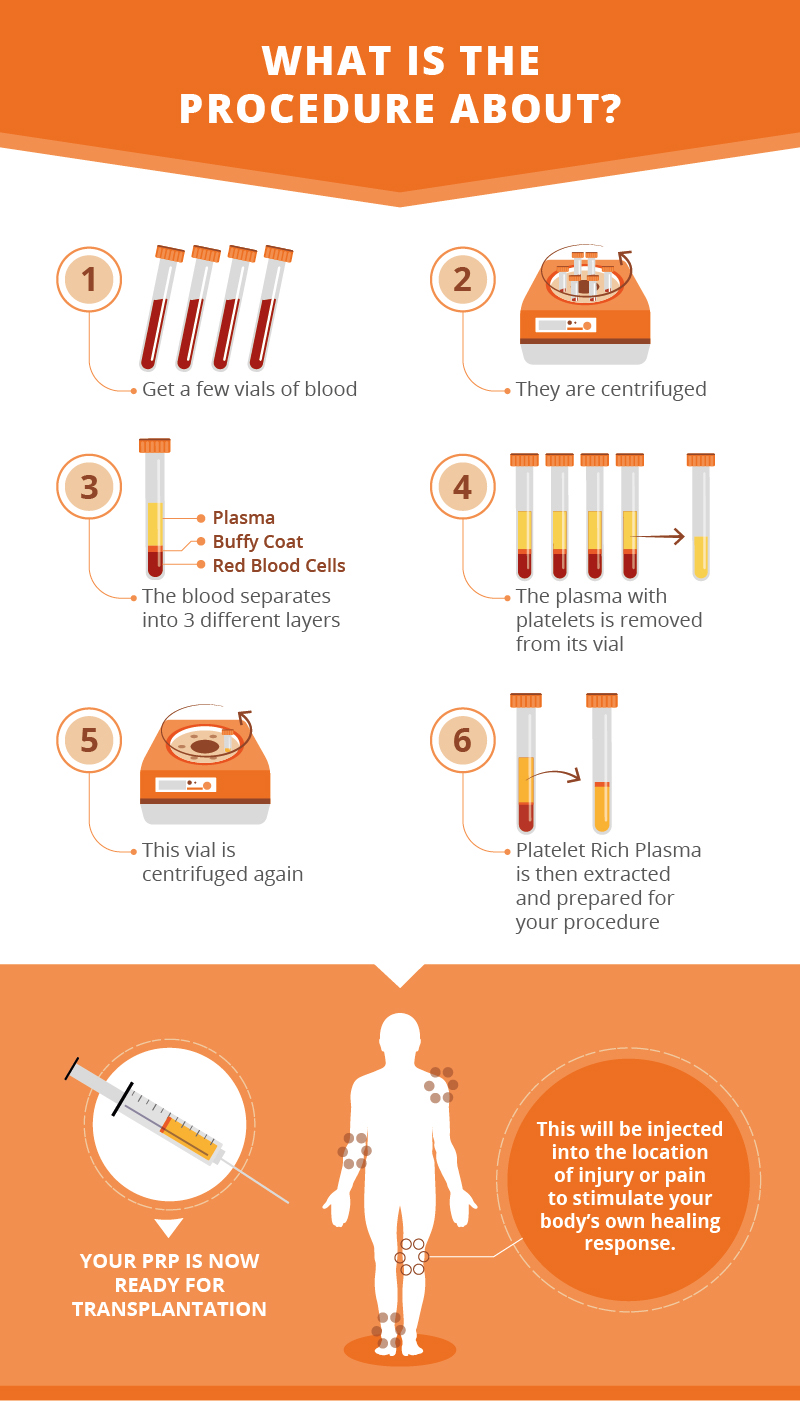
Why is Platelet Rich Plasma important? Is it Safe?
Imagine if after injury or diagnosis of a common ailment that your doctor had the ability to treat you with a medicine that was both natural and 100% guaranteed compatible with your biology.
That’s what Platelet Rich Plasma is! It’s you! Your body, broken down into specialized parts and used as a therapeutic treatment.
While the U.S. Food and Drug Administration has not approved PRP for medical applications, it is important to note that the FDA does not technically consider platelet rich plasma a “drug”. That’s because it is not! Remember, Platelet Rich Plasma is a compound made from the patient’s own natural blood supply. Physicians utilize PRP under “off-label” designation. To use a therapy off-label is legal and common, and simply means that the medical community has found success in a way that the FDA has not yet. An analogous example would be chemotherapy that is approved for one type of cancer, but is also used to treat additional types of cancer.
While PRP is not yet approved by the FDA, it is cleared for use in many situations. The FDA has placed strict guidelines on the preparation of platelet rich plasma, which our facility adheres to vigilantly.
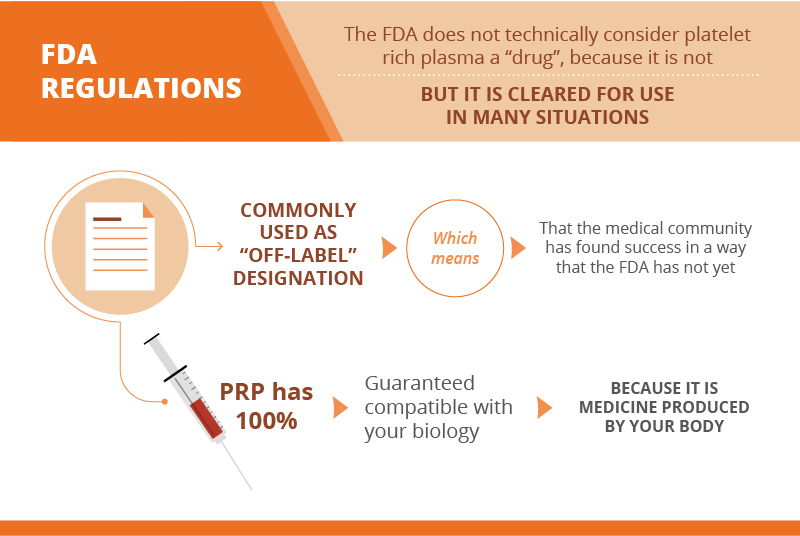
What Medical Problems can Platelet Rich Plasma Therapy Treat?
Musculoskeletal injuries
Torn tendons, tendinitis, muscle injuries, joint injuries and arthritis, osteoarthritis and related pain disorders have all shown great improvements with platelet rich plasma injections. These tissues naturally employ platelets when injured or torn, and so are particularly receptive to PRP therapy. Cases of arthritis, tendinitis and joint pain and most commonly treated with platelet rich plasma. PRPs natural properties stimulate cartilage repair and production and increase synovial fluids in the joint, causing ease of movement and pain reduction. Those who suffer from chronic back pain and spinal injuries are likely to benefit from PRP injections for reduced inflammation and disc repair.
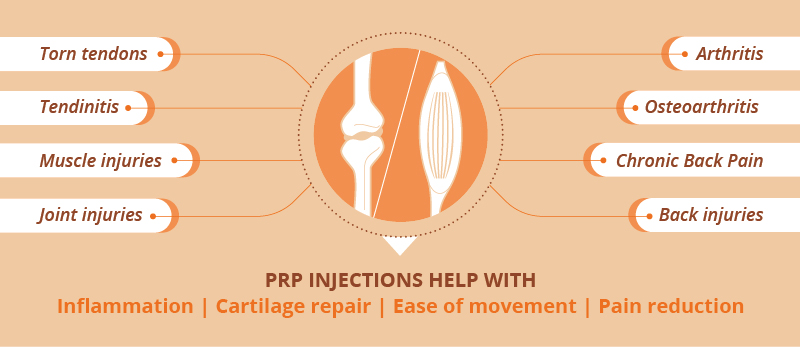
Nerve injuries
Damage to the peripheral nervous system, and resulting conditions such as sciatica and carpal tunnel, respond positively to PRP injections. The nerve tissue uses the platelet rich plasma as an anti-inflammatory and growth stimulator, reducing painful sensation and encouraging repair.

Cosmetic treatments
Platelet rich plasma has been shown effective for both male and female patterned baldness, also known as androgenic alopecia. PRP injections are performed at the scalp to stimulate hair growth and nourish existing strands.
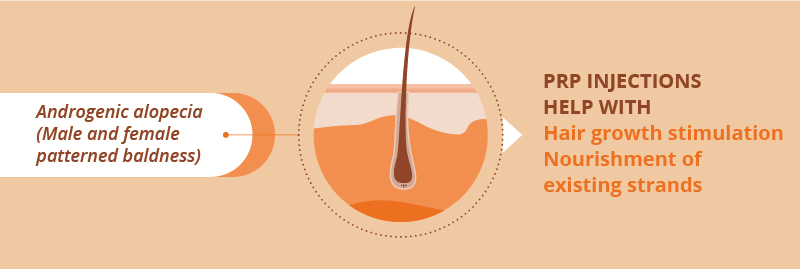
Plastic surgery
Some dermatologists are using PRP injections into tissue around the face and jawline as a minimally invasive “facelift”. This can result in lifting sagging tissue and reducing the appearance of fine lines and wrinkles without the need for surgery. Additionally, since platelet rich plasma supports optimal functioning of the body and repairs tissue damage, receiving PRP can speed the healing process of patients who undergo cosmetic surgeries.

Who can receive Platelet Rich Plasma?
Platelet rich plasma injection therapy can be administered to a vast majority of patients regardless of age, sex, or race. However, as with most medical procedures, there are some considerations. Patients with good overall health who are not suffering from specific skin issues, blood and liver disorders, or diabetes will be the best candidates. Certain medications such as anticoagulants or heart disease medication may impact your ability to receive PRP.
Part II- Does Platelet Rich Plasma work?
More studies are being done to gauge how effective PRP treatments are. Research shows that platelet rich plasma speeds the recovery of athletic injury such as torn tendons and muscle fatigue. In addition to healing injured tissue, PRP studies show that the injections may reduce pain sensation to joint injury and improve mobility. PRP injections appear to reduce hair loss in both male and female pattern baldness, but other cosmetic procedures such as wrinkle reductions and sagging skin are inconclusive. Luckily the widely growing awareness and interest in platelet rich plasma is allowing for more studies and increasing evidence.
As with many medical procedures, it can take several weeks to months for the full effect of platelet rich plasma injections to take place. For some conditions you may need several injections to optimize and maintain the results.
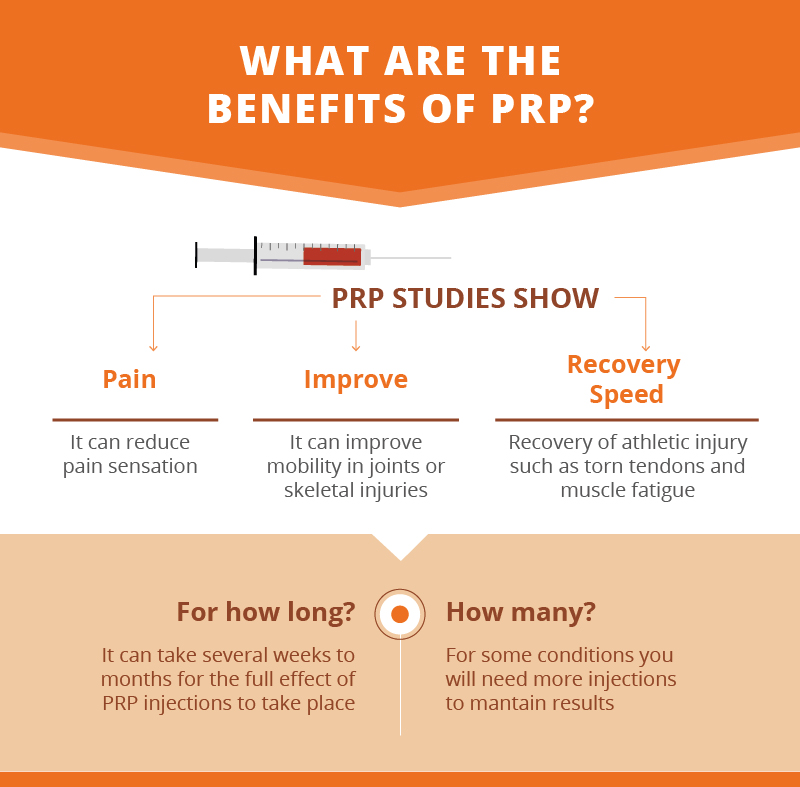
Part III- How to Prepare for Platelet Rich Plasma Therapy
Before receiving PRP therapy, be sure to speak with your doctor about which medications to maintain and when. It may be recommended that you stop taking anticoagulants (“blood thinners”) such as aspirin or ibuprofen 5-7 days before your PRP injection. You may also need to refrain from certain vitamins or supplements such as omega-3 fatty acids.
PRP does not usually cause any major side effects. Since the procedure involves drawing blood, you’ll want to make sure you eat a balanced meal within any dietary restrictions. This will help to prevent any feelings of lightheadedness or dizziness you may experience.
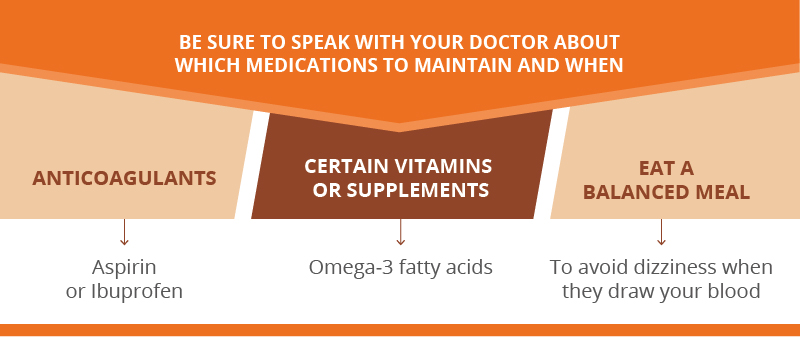
Part IV- How to Maximize Platelet Rich Plasma Results after the Treatment (Recovery and Guideline)
You can maximize your PRP results by keeping your injection site clean, dry and covered with a fresh bandage the day of your procedure. You will be able to shower at any time. Some localized swelling or bruising is normal and may take 3-7 days to recover from. Some patients (about 1-5%) experience an immune system reaction due to hyper-stimulation. This post-injection flare up typically feels like significant pain or swelling at the injection site and almost always resolves itself within a few days.
You will want to avoid using ice at the injection site as the cold temperature halts the progress of the platelets ability to bond with the injured tissue. Additionally, do not use any prescription or over the counter anti-inflammatory medicines for at least 7 days after the procedure. Ideally a patient would avoid these medications if possible for up to 6 weeks.
Some patients require 2-3 days of rest after an injection, depending on the location and severity of their condition. Generally speaking, you may continue your daily living activities such as dressing and cooking right away. Patients who receive injections at the hip, knee, ankle or foot will want to avoid walking long distances.
You can read more about platelet rich plasma recovery time here.
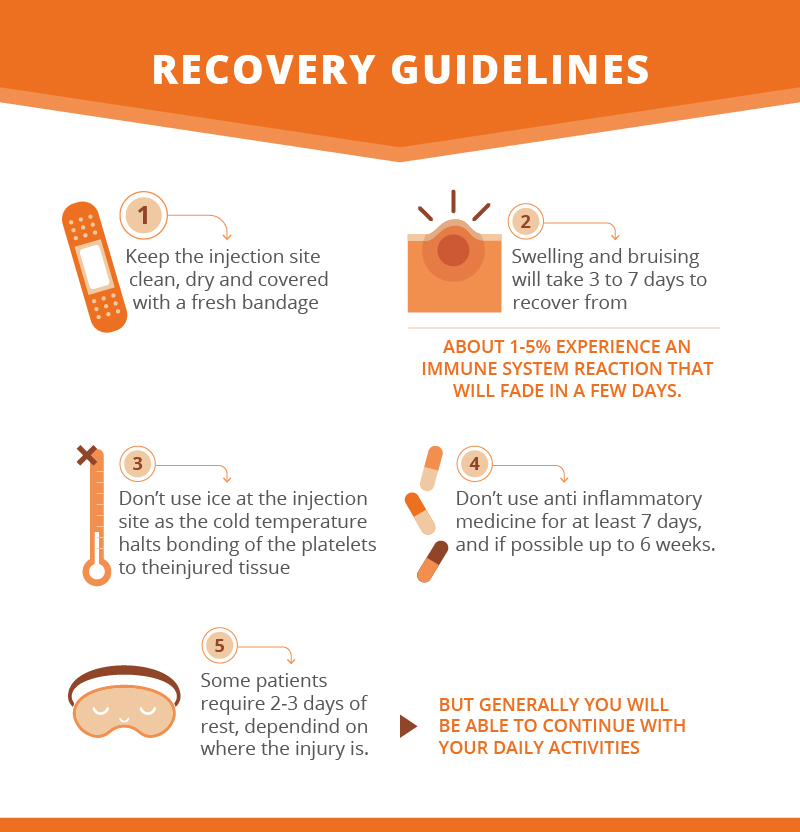
Part V- Frequently Asked Questions and Answers
Q: How long until my PRP results kick in?
A: The results of PRP depend on the area of injection and the injury; some results are noticeable after 48 hours and some may take a few months. Most patients feel relief within 4-6 weeks.
Q: How long will my PRP injection last?
A: Again, this depends on the area of injection and the injury. If you continue the activities which caused the injury, you may need additional injections. It is also possible that these procedures can have near permanent results. .
Q: How many injections will I need?
A: This depends on what disorder you are using PRP to treat. In general, for orthopedic and spine procedures, 1-3 injections are needed for optimal effects, however in cases of cosmetic use more injections may be needed to maintain results.
Q: Are PRP injections painful?
A: There is some mild discomfort associated with having your blood drawn to develop the platelet rich plasma, and then also at the time of injection due to swelling. This discomfort does not last long and is subject to the patient’s tolerance.
Q: Are there any side effects to PRP?
A: Some side effects to PRP include localized swelling at the injection site and mild bruising bleeding, infection, or nerve damage.
Q: Is PRP therapy covered by my insurance?
A: PRP injections are not currently covered by most insurances. Be sure to speak with your doctors about costs and payment plans when considering PRP.
References
https://www.hss.edu/condition-list_prp-injections.asp
https://goviva.ca/wp-content/uploads/2019/02/PRP-Evidence-to-support-its-use.pdf
https://journals.sagepub.com/doi/abs/10.1177/0363546506288850
https://pubmed.ncbi.nlm.nih.gov/21082164/
https://www.ouhsc.edu/platelets/platelets/platelets%20intro.html




